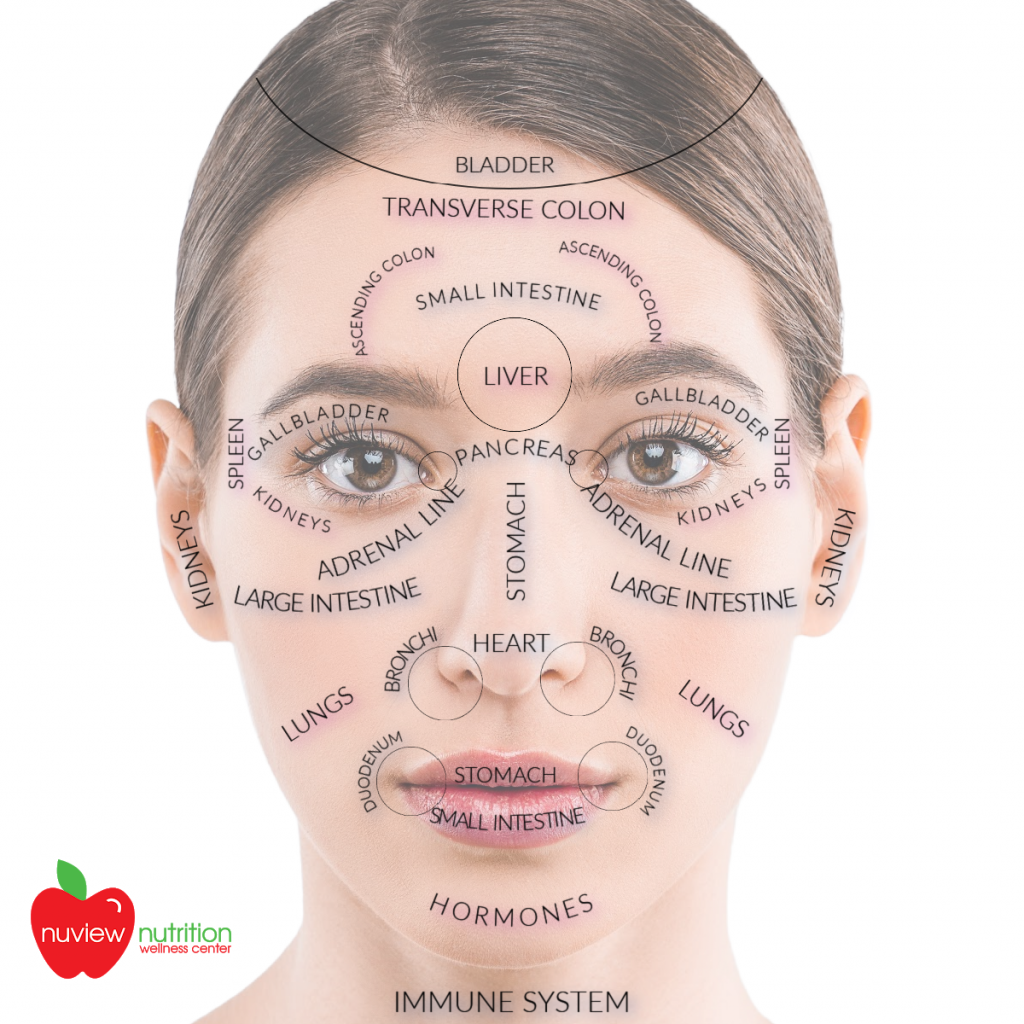Facial skin issues like acne breakouts, dryness, deep lines, redness and signs of uneven skin tone are all incredibly frustrating conditions we could live without. From topical treatments to trips to the dermatologist, we work hard to wipe out the facial imperfections and clear the way for healthy, youthful skin. What if those pesky blemishes are actually your body’s way of sending you a message? Yep, buried deep in those lines and flaws is an underlying SOS, and your body is sending it to you through an ancient technique called face mapping.
What is Face Mapping?
The ancient art of face mapping or reading is a medical technique that has been used since the time of Confucius. It involves reading and making connections between facial characteristics and symptoms and the function of specific internal areas of the body.
Chapman Lee, a Chinese scholar and co-founder of the skincare line Baszicare, gives us a much prettier definition, explaining, “Face mapping is the ability to see the reflection of the body’s organs on each part of the face…”
Simply put, the human face is a map of our past and present experiences, emotions, and health. While genetics do play a huge role in how we look, it doesn’t play the main role. Take, for instance, a set of identical twins, who are often difficult to tell apart when young. As they grow and begin to have their own experiences, their features will begin to shift and change. It could be subtle or dramatic, but the ongoing changes are a reflection of their individual lives and health.
Who Uses Face Mapping?
It’s been around for 3,000 years and doesn’t seem to be going anywhere any time soon. Guess what? Certain physicians may use it on you without you even knowing. Why? It’s a starting point when getting to the bottom of multiple symptoms.
Dermatologists
Modern dermatological science suggests that most skin conditions on the face could give insight to several health issues, such as:
- Hormonal imbalances
- Poor gut health
- Allergies/reactions to environment or skin products
- Genetics
- Sun exposure
- Poor circulation
- Underlying diseases such as diabetes or heart disease
- Environmental exposure to irritants
- Poor sleep
Holistic Health Practitioners
Face mapping is a handy technique for many health practitioners. For them, especially when looking for answers, signs like lines, acne or redness on the face could be representative of underlying issues in major organs such as the intestines, reproductive system, kidneys, liver, and heart.
Facial Analysis
When using facial indicators, practitioners take several characteristics into consideration:
- The shape of the face
- The shape, size, and placement of each feature
- Markings, lines, wrinkles, blemishes, and discoloration of the facial skin
Basic Face Mapping
When there’s a bodily imbalance, physicians who use face mapping will look to the skin for lines, pimples, redness, or dryness. The location of these blemishes on the face could represent the organ that’s affected. The shape and size of these features are also indicators of underlying issues, as well as past experiences and reoccurring emotions.
Shape/placement of hairline:
May be representative of issues with the bladder; may also indicate stress with a parent as an adolescent.
Blemishes/lines on the forehead:
A result of issues with poor digestion through the small intestine and bladder; may also be tied to inherited thinking and unmanaged stress.
Breakouts/redness/lines between/below eyebrows or nose area:
Could represent an imbalance in the liver and gallbladder; may also be representative of issues with alcohol and reoccurring feelings such as anger, pride, confidence, and passion.
Lines/wrinkles/puffiness around eyes:
May represent problems with functions of the liver and gallbladder; may also be connected to the willingness or unwillingness to consider or accept new suggestions and ideas.
Puffiness or redness in inner canthus (where the upper and lower eyelids meet):
Said to represent an underlying issue in the pancreas; may also show signs of constant worry.
Puffiness under the eyes:
Said to be connected to poor kidney and/or adrenal function, as well as a sign of hypo/hypertension; may also indicate unresolved feelings and fear.
Red cheeks/blemishes/lines on cheeks:
Could be representative of issues with the lungs and a compromised immune system: may also be connected to reoccurring feels of grief and despair.
Shape/length/redness/blemishes on nose:
May be connected to underlying issues of the lungs and stomach; could also represent a big ego, drive, and capacity for power.
Shape/size/redness/blemishes on tip of nose:
Could represent issues of the heart; could also be indicative of feelings of love.
Size/redness/blemishes of nostrils:
May be representative of poor lung function; could also be indicative of energy levels.
Shape/size/blemishes/up/downturn of mouth:
Might indicate issues with the digestive system and duodenum; could also represent generosity, feelings of home and safety, and sexuality.
Acne on the chin, around the mouth and on the jaw:
Said to be due to imbalance in reproductive system and/or hormones.
For more on facial diagnosis, read Why the Face: A Practical Guide to Understanding Health and Personality Through Facial Diagnosis by Dr. Todd Frisch and Abbie Belliston-Frisch.
Final Thoughts
Face mapping is a technique that many are growing curious about and using more. There are zero risks involved, as it is simply a starting point. From there, your practitioner might have an idea of where to begin when taking a functional medicine approach to uncovering your underlying issues. Let our team of experts design a customized plan that will address your underlying issues and give your body the right environment to heal itself! Get started today and RSVP for one of our free meet and greets on the 1st Tuesday of every month at 6:30 pm and save $50.00 on discounted package pricing! 248-625-5143
Adrian Schirr
Forum Health Clarkston
7300 Dixie Hwy. Ste 500
Clarkston, MI 48348
248-625-5143

